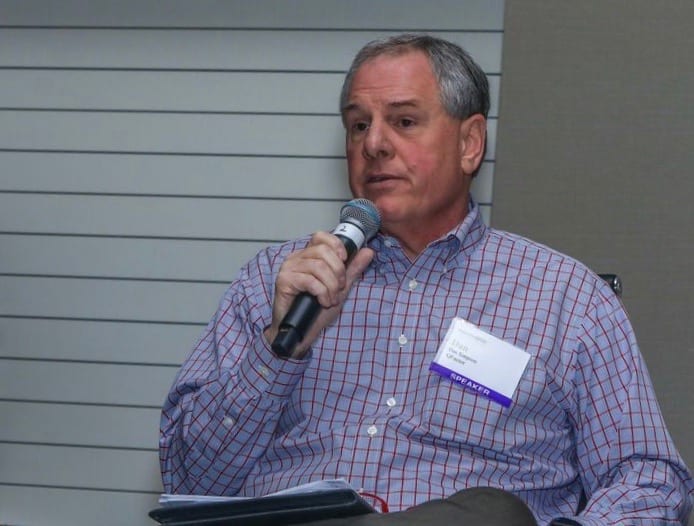Roof replacements in Denver rolled out to what may have been a record in 2017.
The city of Denver issued 18,475 permits for new roofs last year, 54.6 percent more than the 12,016 in 2016, according to data from Denver Community Planning and Development.
Overall, permit activity in Denver was up 17 percent in 2017 from 2016.
It’s not surprising that so many buildings received new roofs last year.
In May, a hailstorm caused $1.4 billion in damages in northwest Denver and in areas to the west, such as Wheat Ridge and Lakewood.
Literally, every home in my West Highland neighborhood received a new roof last year. And, of course, the Colorado Mills shopping center in Lakewood was closed for months, after hail of 6 inches or more in circumference pummeled its roof like mortar fire.
But did the Green Roof Ordinance, adopted by Denver voters Nov. 7, cause a spike in roofing permits? After all, the ordinance does not impact homes.

Dan Simpson speaks about the Green Roof Ordinance in Denver during a recent CREJ conference. Photo credit: Rocky Mountain Photography.
Dan Simpson said there was.
There was a “big influx” of roofing permits in Denver in December, as developers sought to get under the wire of the new Green Roof Ordinance that took effect Jan. 1, Simpson said last Thursday at the 15th annual Property Management Conference & Expo sponsored by the Colorado Real Estate Journal.
The city doesn’t agree.
“By our read, there wasn’t a significant impact from the Green Roof Ordinance,” said Laura Swartz, a spokeswoman for CPD.
“Ultimately, we aren’t able to say conclusively that the ordinance impacted roof repair/replace permits since the trends are consistent with past results,” Swartz added.
I looked at the roof replacement data and found that permits in December were up 74.9 percent in December from December 2016.
That would seem to back Simpson, who is director of management services and reporting for developer Q Factor. Q Factor is the developer of the highly acclaimed, re-adaptive building Industry Denver workspace in RiNo.
On the other hand, December roof permits accounted for 6.3 percent of all roofing permits last year, while in December 2016, the permits accounted for about 5.6 percent of all of the roof permits issued that year.
And that city didn’t start to ask the size of the buildings seeking roof permits until this year.
“As of Jan. 1, our roof permit applications do ask if the square footage is over 25,000 since this is the threshold for the green roof requirement,” Swartz said. “The city has not yet received any applications for roof replacements that would be subject to the ordinance since it went into effect.”
If developers didn’t seek to get permits for a new roof, maybe they should have.
Simpson noted at the CREJ conference that Denver now has the country’s “most stringent green roof ordinance.”
The problem isn’t so much constructing a new building with the systems and the strength to handle a green roof. Developer Kyle Zeppelin told me that adding a green roof to new buildings in Taxi added about 1 percent to the cost.

Shown is a green roof on Zeppelin Station, soon after vegetation was planted.
But the ordinance requires a green roof on larger buildings when it comes time to replace the existing roof.
Currently, it costs about $25 to $30 per sf to add a green roof, compared to $8 per sf to roll out rubber EPDM on a roof, he said.
He described a situation where a replacement 10,000-sf green roof could cost $225,000 or more.
There also are concerns about having plant material close to air intakes in cooling towers, which might spread diseases in buildings, watering vegetation on roofs and the cost of maintaining it, he said.
City Councilwoman Kendra Black raised similar concerns in a recent Denver Post editorial.
Even native Xeriscape plants will “take 12 to 18 months of daily watering to get them established,” Simpson said.
Proponents of green roofs, he said, say that green roofs will last twice as long as a standard roof, but he said he hasn’t seen any data to back that claim up.
He said a simpler and less costly solution to address the heat island effect of roofs would have been to require a “white EPDM membrane, which would have caused a lot less of a hardship and capital costs.

Hail this size caused an estimated $1.4 billion in damages to parts of Denver, Wheat Ridge and Lakewood last spring.
He noted that a group of 25 people from a variety of industries have scheduled seven, three-hour meetings to review the ordinance and “work within the existing structure to come up with something palatable to everyone.”
The City Council can amend the ordinance after six months, but it takes a super majority vote, he said. Council members have said they don’t plan to overturn the ordinance, although theoretically they could.
“We have a lot of roadwork ahead” on the green roof ordinance, Simpson said. “A lot of uncertainty and a lot of unknowns.”
If the ordinance isn’t amended, it could cost Denver a lot of business, he said.
“If I was the mayor of a competing city, I would say, ‘Come here instead of Denver. It will cost you a lot less.’”
And while last year might have been in record territory for new roof replacements, going forward he said developers may try to get around the green roof replacement by simply patching roofs, instead of replacing them.














